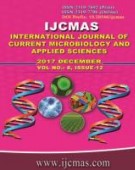


 National Academy of Agricultural Sciences (NAAS)
National Academy of Agricultural Sciences (NAAS)

|
PRINT ISSN : 2319-7692
Online ISSN : 2319-7706 Issues : 12 per year Publisher : Excellent Publishers Email : editorijcmas@gmail.com / submit@ijcmas.com Editor-in-chief: Dr.M.Prakash Index Copernicus ICV 2018: 95.39 NAAS RATING 2020: 5.38 |
Seed coating polymer is a product in which additives are dissolved or dispersed in a liquid adhesive, usually a dyed solution of a polymer, into which the seeds are dipped or sprayed before drying. The objective of the present study was thus to develop a ‘seed coating polymer formulation’ and standardize the optimum dosage for coating of seeds and assess their effect on seed germination and plant growth characteristics of cotton. The seed coating polymer formulation was developed by mixing ingredients such asMurashige and Skoog medium, carboxy methyl cellulose, gelatin, glycerol, bone meal, dicalcium phosphate and pectin in appropriate quantities along with optimum quantities of synthetic polymer, pigment and water. The formulation was used for coating seeds in three different dosages such as 20, 30 and 40 g Kg-1 of seeds and assessed for effect on seed germination characteristics as well as initial seedling vigour in nursery bed laid in a shade house. The effect on plant growth and productivity was evaluated by adopting a field trial in randomized block design. The observations were made on various growth and yield attributes. The results revealed a gradual increase in all the seed germination characteristics observed, as the dosage increased. The final seed yield recorded (Kg plot-1) and 100 seed weight (g) was also found to be highest when the cotton seeds were treated with 40 g kg-1 as it recorded 116.84 and 15.25 per cent increase over control and 44.05 and 12.84 per cent increase over 30 g kg-1. The results of the present experiment brought out the positive impact of seed coating polymer formulation on plant growth, chlorophyll content, branching pattern, boll yield, seed yield and 100 seed weight in all the dosages experimented viz., 20, 30 and 40 g kg-1 , however the highest improvement was recorded in 40 g kg-1. The crop growth and yield improvement is attributed to the increased activity of rhizosphere microorganisms and eventual increase in mobilization of nutrients to the plants resulting in enhanced crop growth and productivity.
 |
 |
 |
 |
 |